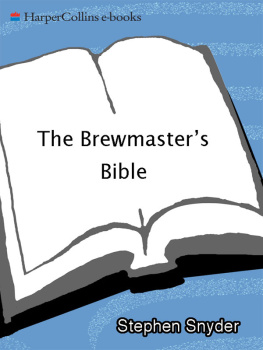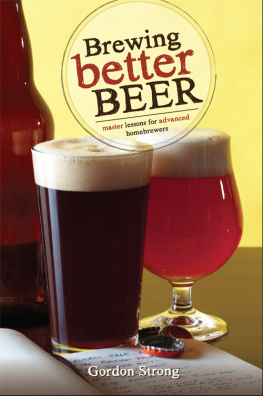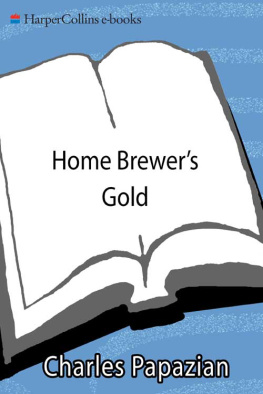I would like to extend a special word of thanks to my agents Susan Urstadt and Jeanne Fredericks for their hard work and enthusiasm, my editor Sharon Bowers for making this book better than I had ever thought possible; Susan Friedland for her great faith in this project; all the Bards of Beer for sharing their vast knowledge; and for their immeasurable contributions to this books growth along the way, Paul White, Al Korzonas, and Dr. Alfred Haunold for technical direction; Bruce Fiene and Tracy Wheeler for photography and moral support, Byron Burch and Nancy Vineyard, Carlos and Rico Perez for their generous help in this projects infancy, Daniel S. McConnell, David Logsdon, Dr. Paul Bosken-Diebels, Iain Loe, James and Vera Melton for their undying interest in beer facts, and last but not least, the creator of saccharomyces.
I nitially, this book started out as a resource for my own personal use, but as I began collecting helpful brewing data to put in a notebook with my own recipes, I realized how much more I needed to learn, and also how much contradiction existed in the information available on brewing products. By soliciting information from over two hundred homebrew supply shops and dozens of professional craft brewers in an effort to gather information, I was finally able to resolve many discrepancies, and in the process found that these shops had a lot of great recipes that they were graciously willing to share. It was then that I realized that this was information other homebrewers might find useful as well.
My hope is that this information will help you have more fun and grow as a brewer, but remember, these recipes are not sacred and do not have to be strictly adhered to. Feel free to use them as an outline for your own recipes; they are a map to guide you in discovering what works and tastes best for you. Dont forget that the foundations of homebrewing lie in trusting your own instincts, expressing your creativity, and most of all, exercising your freedom to brew the beer you want.
Last, but not least, I want to preface this manual by thanking the many beer writers who shared their vast knowledge, but especially the professional craft brewers and homebrew shops who generously lent their recipes and expertise for the creation of this book. They, as my aunt Ethel would say, didnt know me from a sack of turnips, but they took the time to send me recipes and other information, often during their busiest time of year, proving the old adage, If you want to get something done, ask a busy person to do it. I owe them a huge debt of gratitude.
T here is an old saying, The truth is rarely pure and never simple. This is nowhere more appropriate than in the world of beer, despite the fact that all beer has roots in just four simple ingredients: water, malt, hops, and yeast. Even the name of our beloved beverage is a source of contention and confusion. Many people prefer to call warm-fermented beers ales and cool-fermented beers lagers. Others take issue with this, however, because lager merely comes from the German verb meaning to store and has nothing to do with color, content or method of brewing. German altbiers are ales, after all yet they are cold-lagered; German wheats are often fermented with ale yeast then bottle-conditioned with lager yeast. Further-more some even feel the word beer should be used only to identify products where the yeast settles to the bottom during fermentation (bottom-fermented) and ale should be used exclusively for a product where the yeast rises to the top during fermentation (top-fermented). In fact, beer itself was once a term specifically used to differentiate malt beverages flavored with hops from ales, which were once flavored exclusively with other bitter herbs and spices.
The long and short of all this is that the lines between beer styles cross and crisscross, have two or more names, or have varying fermentation and conditioning methods from country to country and region to region. Therefore, in order to simplify matters for the practical purposes of homebrewing, I refer to all beverages herein as beer and have divided the recipes (for five gallons, unless otherwise noted) into three main sections: Top-fermented beers will be termed ales and bottom-fermented beers will be classified as lagers. There is also a shorter third section of Specialty Beers that includes rare Bavarian styles, seasonal Holiday Beers, or beers that use fruit or spices as flavoring agents; this section includes both ales and lagers.
Youll notice some of the recipes may fit into more than one category, particularly American versions of the classic styles. Some of these are included in the appropriate American sections, others in the European sections; in most cases, the ingredients used, especially the yeast and hops, were the deciding factors in where the recipes would be placed. Youll also see that brand names or specific products are recommended in some recipes. This is not for promotional purposes or because weve received a kickback from the manufacturer but because it was the product used in the original recipe, it is the best one for the job in the brewers humble opinion, or it is true to the style of the beer due to the physical properties of its ingredients (that is, a continental American malt for a steam beer or a maritime German malt for a helles). The same is true for the hop alpha acid percentages given. Since it may be difficult in future years to find hops with the exact alpha acid percentage (AA%) as given, use the HBU/AAU/IBU formulas to adjust what alpha acid percentage you have to the ones given in the recipe. Otherwise use whatever you have available and what suits your personal taste. Good luck and happy homebrewing!
T his book was designed as a collection of recipes in the classic beer styles, a reference tool to the myriad homebrewing ingredients, and as a recipe formulation tool. To that end, a working knowledge of classic beer styles, their ingredients, and the brewing methods should be obtained by studying all the preliminary sections of this book before formulating an entirely new recipe of your own. By providing you with a solid background in the component parts and the techniques for bringing them together, you will be able to create a successful brew and to master a variety of brewing methods and beer styles. If you are an experienced brewer, you can skip this beginners section and get right to the recipes, although a glance at the ingredient profiles and the formulation tables may be a good refresher.















 RRD 30 29 28 27 26 25 24 23 22 21
RRD 30 29 28 27 26 25 24 23 22 21